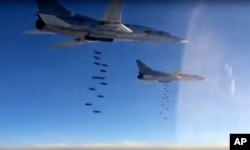The Pentagon is questioning Russia's decision to add more air defense missiles to its military operation in Syria.
Pentagon Press Secretary Peter Cook called on Russia to "explain" why it would deploy S-300 surface-to-air missile systems to Syria. The weapons were developed to defend against aircraft and cruise missiles.
"ISIL doesn't have an air force and neither does Nusra [Front], which are the two groups the Russians have said they're most concerned about," Cook said, using an acronym for the Islamic State.
The only aircraft known to be flying in Syrian airspace are either Syrian, Russian or part of the U.S.-led coalition.
Cook told reporters at the Pentagon that the U.S. will do everything to ensure the safety of coalition air crews.
"Those air crews as well, I should point out, have the inherent right to self-defense," Cook said.
While diplomatic bilateral discussions have ceased, the Pentagon said U.S. and Russia will maintain military-to-military communications in order to avoid incidents in the skies over Syria.
'Defensive move'
Russian Defense Ministry spokesman Major General Igor Konashenkov said Tuesday a battery of the S-300 systems were sent to Syria as a defensive move to protect Russian navy ships off the Mediterranean coast and a Russian facility in the Syrian port of Tartus.
Russia already deployed the S-400 air defense missile system to Syria last November. Moscow had said it was part of a security boost after Turkey shot down a Russian jet that Turkey said was in its air space.
"They have air defense systems in Syria; we've seen them," Cook told reporters at the Pentagon.
News of the recent S-300 deployment comes a day after the U.S. State Department announced the suspension of bilateral talks with Russia, which were set up to sustain a cessation of hostilities in Syria.
"This is not a decision that was taken lightly," State Department spokesman John Kirby said.











